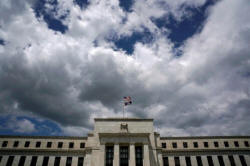|
U.S. bank investors hope
Fed stress test results lead to big payouts
 Send a link to a friend
Send a link to a friend
 [June 19, 2017]
By Pete Schroeder and David Henry [June 19, 2017]
By Pete Schroeder and David Henry
(Reuters) -
Investors
are hoping the Federal Reserve will allow big U.S. banks to put an
estimated $150 billion in idle capital toward stock buybacks, dividends
and profit-boosting investments in the coming weeks after conducting a
regular examination of financial strength.
On Thursday, the Fed is scheduled to begin releasing results from its
two-part annual stress test, which was adopted in response to the
financial crisis, to gauge banks' ability to weather an economic storm
that could threaten the stability of the system. The results will be the
first since Republican President Donald Trump took office.
Trump has not yet made any appointments to the Fed, but Republicans have
turned up pressure on the central bank to cut red tape and ease
regulations. Wall Street analysts said they will be parsing language the
Fed uses in presenting the results for any signs that its approach is
starting to soften.
Analysts say they do not expect the Fed to announce any explicit changes
to the stress test, but they do expect higher payouts. According to
their estimates, the Fed could allow banks to distribute nearly as much
capital to shareholders over the next year as they generate in profits,
a benchmark not hit since before the 2008 crisis.

Higher payouts "would be significant from a signaling standpoint" that
regulators are easing up on capital requirements, said Steven Chubak, a
bank analyst at Nomura Instinet. "That is a key part of the value case
for a lot of these stocks."
Banks going through the stress tests have roughly $150 billion more
capital than they need, Morgan Stanley analyst Betsy Graseck estimates.
She expects the typical big bank to be allowed to increase stock
buybacks by 27 percent and dividends by 8 percent, for a combined
capital payout of 95 percent of annual earnings, up from 84 percent last
year.
The Fed first conducted stress tests in 2009 as a way to boost
confidence in the financial system. Congress codified the test into law
the following year as part of a broader financial reform package, and
the Fed came to see it as an important tool to ensure that banks not
only maintain enough capital to withstand economic storms, but also run
their businesses in ways that avoid operational calamities.
However, bankers complain that stress tests have morphed into an overly
complex and time-consuming process that occurs in the secrecy of a black
box. They have pleaded for more details about models the Fed uses to
conduct the numeric part of the tests, and more clarity on a qualitative
component that judges factors like risk management.
[to top of second column] |

Flags fly over the Federal Reserve Headquarters on a windy day in
Washington, U.S., May 26, 2017. REUTERS/Kevin Lamarque

The Fed has been making some changes to enhance transparency, but officials say
that revealing too much would allow lenders to game the exams.
"We are concerned that releasing all details on the models would give banks an
incentive to adjust their business practices in ways that change the results of
the stress test without changing the risks faced by the firms," Fed Chair Janet
Yellen told Congress in a letter on Friday. "The result could be less effective
stress tests."
Thursday's results, known as DFAST, will show how much capital the biggest banks
would have after an imagined crisis. Shortly after the Fed posts its numbers,
big banks tend to disclose results under their own models.
Banks
can compare the scoring and then scale back and resubmit their capital plans to
improve their chances of a passing grade. On June 28, the Fed will announce
whether it has approved the plans in a further examination known as the
Comprehensive Capital Analysis and Review, or CCAR.
The Fed has been under pressure for some time to simplify the stress tests, and
changes are widely expected under Trump.
A proposed financial regulatory overhaul ordered by Trump and released by the
Treasury Department last week included easing stress tests. Trump is also
expected to name as many as five new officials to the Fed's seven-member
governing board over the next two years.
Although Wall Street is upbeat about the idea of lighter regulations and higher
payouts, regulatory experts are less sure that the Fed will unleash bank balance
sheets overnight. It takes time for large institutions like the Fed to shift,
even after top officials and regulatory mandates change, they said.
"It should change over time," said Brian Gardner, a policy analyst at Keefe
Bruyette & Woods. "Markedly? That's tougher to determine."

(Reporting by Pete Schroeder in Washington and David Henry in New York; Editing
by Lauren Tara LaCapra and Leslie Adler)
[© 2017 Thomson Reuters. All rights
reserved.] Copyright 2017 Reuters. All rights reserved. This material may not be published,
broadcast, rewritten or redistributed. |